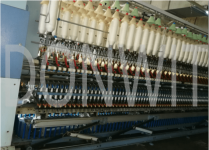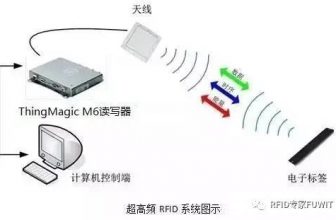
RFID application solutions in the textile spinning industry
[ad_1]
1. Project Overview
1.1 Project background
The increasingly fierce market competition, improving production efficiency and reducing operating costs are of vital importance to textile spinning enterprises. At present, ERP/MES management systems usually use bar code labels or manual management documents to support their own management methods. However, the characteristics of easy copying, non-fouling, non-moisture-proof, and cumbersome operation of barcodes, as well as the cumbersomeness of manual writing of documents, are likely to cause human losses, which make current domestic production and warehouse management always have defects.
The application of radio frequency identification (RFID), the latest technology product, can fundamentally solve the above-mentioned problems. Based on radio frequency identification (RFID) technology, Hangzhou Dongshi Technology provides customers with RFID textile spinning industry material tracking system solutions according to the actual situation and needs in the spinning industry production and warehouse management.
1.1 Introduction to RFID
RFID is the abbreviation of Radio Frequency Identification, which is a non-contact automatic identification technology. RFID can be traced back to the Second World War (around 1940), when the main function of RFID was to distinguish between enemy and British aircraft. In recent years, with the development of large-scale integrated circuits, network communications, information security and other technologies, as well as the promotion of the world’s number one retailer Wal-Mart and the U.S. Department of Defense, RFID has been rapidly applied to smart grids, transportation, logistics, medical and health, Fine agriculture and animal husbandry, finance and service industry, industry and automatic control, smart home, environment and safety inspection, public safety, national defense and military, smart city and other industries and fields.
RFID is to automatically identify target objects and obtain related data through radio frequency signals, and is mainly composed of electronic tags (Tag), readers (Reader), and antennas (Antenna). The tag is composed of a coupling element (also called an antenna) and a chip. Each tag has a unique electronic code (EPC), and the chip can store a specific serial number and other information. The reader is the connection bridge between the tag and the software system. On the one hand, it reads the tag information, and on the other hand, it communicates the reading result with the software system. The antenna exists in the tag and the reader, and is responsible for the data transmission task from the tag chip to the reader to the software system.
RFID technology is divided into low frequency, high frequency, ultra high frequency, active, etc. according to the frequency band. RFID technology has non-contact, fast scanning, high identification efficiency, not easy to damage, suitable for harsh environments, convenient operation, and fast reading and writing speed. Large amount of information storage, one card for multiple uses, anti-collision, good security and encryption performance, reusability, tracking and positioning.
1.2 Project goals
Through the use of RFID technology, in the textile spinning industry warehouse and production management process, the process management of raw materials and material circulation is realized, and the accuracy of ERP/MES system data is provided. The main goals are as follows
1 Improve the timeliness and accuracy of system ERP/MES data
Many aspects of traditional management use manual registration, which is easy to make mistakes; due to manual failure to register in time, the data of the ERP/MES system is not accurate enough.
2 Automatically collect data to improve work efficiency
Automatic data collection in the process of entering and exiting the warehouse improves production efficiency.
3 Provide leaders with a basis for decision-making analysis
The data can be analyzed online or generate reports for leaders to make decisions and analyze.
1. System Management
2.1 Raw material management
RFID is used to collect the in and out management status of the warehouse raw materials to accurately manage the raw material inventory.
2.2 Carding and drawing
Install an RFID reader on the track. When a barrel passes through the collection of barrel information and transmits it to the background system to track the production process, if the barrel is placed in the wrong position during the production process, the system automatically reminds.
2.3 Roving
Before the roving enters the machine, the roving information is automatically collected and sent to the background to perform real-time control of the roving during the production process.
2.4 Spinning
Before the roving is out of the machine, the roving information is automatically collected and sent to the background to perform real-time control of the roving during the production process.
2. Hardware introduction
3.1 RFID reader
The high-frequency DW201 production line reader is one of the medium-power reader series products independently developed by our company. The reader can read the electronic tags of multiple manufacturers that meet the ISO/IEC15693 and ISO18000-3 standards; this product The processing speed is fast, and it has a good anti-collision processing algorithm, and the recognition speed is up to 50 frames per second. This product can be widely used in many fields such as production line management, jewelry inventory, chip anti-counterfeiting, and drug management.
Main features:
1 Working frequency: 13.56Mhz;
2 Support agreement: ISO15693 and ISO18000-3 standards;
3 RF output power: 1.5W or more;
4 Antenna interface: 1-4 SMA (50Ω);
5 With fast anti-collision processing algorithm, the reading speed of tags is up to 50 sheets/sec;
6 Reading distance reference: single antenna is about 65CM; (this feature is related to card performance and antenna size);
7 Communication interface: RS232&RJ45;
8 Support noise detection, can detect whether there is interference in the environment;
9 The product integrates a relay output;
10 Power supply: 12V DC
11 It has a variety of working modes, which can be configured through software tools.
Physical characteristics:
12 Shell material: aluminum alloy
13 Size: 145x104x27MM
14 Weight: 290 grams
3.2 RFID antenna
product description:
Dongshi high-frequency antenna is designed for production line and cabinet. It is suitable for industrial automatic control, production tracking, book self-service machine and other fields.
Product parameter
1 Working frequency: 13.56Mhz
2 Radio frequency interface: SMA
3 Maximum support power: 2W
4 Reading distance: 20cm
5 Size: 12*16cm
6 Working temperature: -20°C–60°C
7 Storage temperature: -25°C–70°C
8 Housing material: ABS
Typical application areas
9 Production automation
24-hour street automatic library
3.3 RFID handset
3.4 RFID tags
[ad_2]






